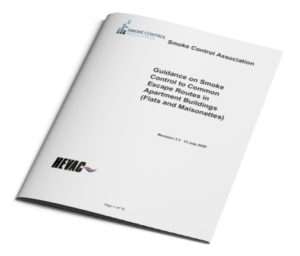In the smoke control module of the Grenfell Inquiry, we recently saw much debate about the suitability of the products used and the performance criteria of the system. Moreover, there was an apparent lack of clarity about what standards the products and the system should comply with. This admittedly was not a common situation, being a refurbishment of a building with an existing system that complied with no standards. However, it is not uncommon in our experience for specifications to be vague when using fire-engineered solutions in preference to Approved Document B guidance.
This causes problems for Main Contractors and M&E contractors as although specific standards may not be explicitly referenced in the relevant part of the consultant’s specification, they can be applied through a general mention elsewhere in the documentation. For example, in a list of applicable standards in an appendix or referred to in a document that is referenced like BS 9991, which mentions other guidance extensively.
Fire engineered vs ADB routes to compliance
When following the prescriptive guidance in ADB, the relevant product standards and performance criteria are clearly laid out and referenced so there should be minimal room for confusion. Even so, there is still room for (mis)interpretation of the standards, for example on cable categories to BS 8519. However, in general terms, all parties should have a clear understanding of the performance objectives.
For fire-engineered solutions, particularly mechanical extract systems, it is advisable when assessing proposals to know which standards can apply and include them in the tender documentation. This will help to protect contractors against possible claims further down the line. The good news is that the list isn’t long (2 documents) and lends itself to a standardised approach that can be applied to all projects.
Read on for our tips for avoiding nasty surprises in your smoke control proposal.
The Big Two

Smoke Control Association Guide
Guidance on smoke control to common escape routes in residential buildings
For the design of mechanical extract systems, and for product standards, the SCA’s Guidance on smoke control to common escape routes in residential buildings is the only document that comprehensively covers this application and references all relevant documents. If you only reference one document, then this would be the one to use as it covers all bases for high-rise residential buildings.
Requiring specialists to confirm that the proposal is fully in accordance with this document is the best way to ensure that the design and products meet current best practice. Any reluctance to commit to this by a specialist should set alarm bells ringing and prompt further investigation.
BS7347-8 Components for smoke control systems. Code of practice for planning, design, installation, commissioning, and maintenance
This rarely referenced document forms the basis of the IFCSDI/19 third-party certification scheme and is a catch-all for the implementation of all systems. It covers everything from detailed design to maintenance in some detail and ensuring that smoke control specialists are working to this will make the project run as smoothly as possible.
Requiring specialists to explicitly confirm that implementation will be to this standard gives an excellent framework for the project management and installation including all relevant documentation including commissioning and handover.
The other important product standards
As we said earlier, tying a vendor to the SCA guide will by inference cover all of the important standards. However, we also consider the most common deviations from the regulations and give an idea of the cost-benefit for cutting corners.
The SCA recently produced a white paper highlighting common grey areas where cost-cutting frequently occurs and advising on the industry best practice we should be aiming for in each case. These are discussed below with our estimation of the cost difference for the specification compliant product and the cheaper alternative.
Smoke Shaft Dampers
The current version of the SCA Guide to smoke control in apartment buildings specifies that products should be multi-zone smoke control dampers CE marked to BS EN 12101 Part 8.
There are several low-cost approaches proposed for this application, including fire doors with actuators or even magnets, bolted onto them and fire dampers with fail-safe mechanisms removed and replaced with actuators. However, these products do not comply with a single harmonised standard. This means they are not CE/CA marked and therefore contravene the Construction Products Regulation.
Cost difference
The cost difference between a certified BS EN 12101:8 multi-zone smoke damper and an ad-hoc uncertified actuated fire door can be as much as £615.00/unit so on a large project this will be significant.
Control Panels
There are two relevant standards applying to controls for smoke control systems. The SCA guidance specifies compliance with both:
- BS EN 12101 Smoke and heat control systems: Part 10 power supplies is harmonised under the Construction Products Regulation that refers to the power supply equipment side;
- BS ISO 21927-9:2012 Smoke and heat control systems. Specification for control equipment covers everything else.
There are many products on the market giving the illusion of compliance with this standard with the use of terms like “designed in accordance with”, but without test evidence or a declaration of performance to prove the certification, they are non-compliant and compromise on safety. Control equipment complying with the EN54/4 fire alarm standard is also commonly used in this application. Each floor of a smoke shaft system will typically have a local control panel so they are plentiful on most projects.
Cost difference
The installed cost difference for a certified product over an untested unit is around £300.
Smoke extract fans with inverter control
Requiring fans to modulate their speed in fire conditions can be a minefield! BS EN12101-3 states that the fan and inverter combination should have been fire tested together, however, the fire test is carried out at a single speed so some fan manufacturers state that the fan is not certified for modulation in fire conditions even if the fan and inverter have been tested. The additional cost for a tested combination could be as much as £1200/fan set but this does not guarantee there won’t be comebacks over certification. Our advice is to avoid systems that use modulating fans in emergency mode.
Ductwork
Any smoke control ducts should as a minimum be classified to BS EN 13501-4. Particularly, multi-compartment smoke control ducts shall be tested to BS EN1366-1 and the BS EN1366- 8. Single compartment smoke control ducts shall be tested to BS EN1366-9, to be safety compliant.
Unclassified ductwork is often used for external sections as a cost-saving measure. However, there is no justification for this in any of the standards so there is a risk involved with this.
Cost difference
The cost depends on the amount of ductwork, but can be considerable.
Electrical wiring
Cables should comply with the following categories for fire survival in accordance with BS 8519 as appropriate for different applications:
- Category 1 (PH30/F30 minute survival time) – activation and monitoring only
- Category 2 (PH60/F60 minute survival time) – Means of escape systems
- Category 3 (PH120 + Annex B/F120 minute survival time) – Firefighting systems
The vast majority of smoke control cables will be categories 2 and 3.
Cost difference
Incorrect cable classifications can be a source of cost-cutting and the installed variation between categories can be as much as £5/m and the cost of rectifying incorrectly selected cables after the fact can be significant.
So what does this mean for contractors?
Contractors placing specialist packages always face the challenge of being less informed on the specialism than the vendor and don’t have the time or the resources to analyse every bid in detail. For fire safety packages there is an increased expectation that reasonable due diligence will be undertaken and “they say it’s compliant” is not likely to be an acceptable level of scrutiny.
As with all trades, we advise caution on placing a package with a vendor whose price is dropping out of the bottom without some further investigation. In our experience, the above are the most likely areas where the difference will be. We hope you find this is a useful tool and would welcome your feedback.


